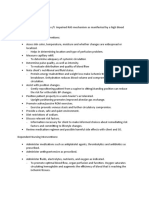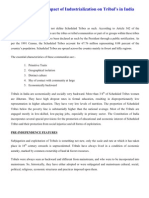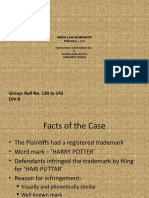Drug Study
Drug Study
Uploaded by
Hennah ReblandoCopyright:
Available Formats
Drug Study
Drug Study
Uploaded by
Hennah ReblandoCopyright
Available Formats
Share this document
Did you find this document useful?
Is this content inappropriate?
Copyright:
Available Formats
Drug Study
Drug Study
Uploaded by
Hennah ReblandoCopyright:
Available Formats
Generic name
Brand name
Classification Indication
Contraindication Adverse reaction
Nursing considerations Assess patients condition.
Ibuprofen
Alaxan FR
Non-steroidal antiinflammatory drugs (NSAIDS)
Faster relief of mildl to moderately severe pain of musculoskeletal origin.
Patients in whom bronchospasm, angioedema or nasal polyps are precipitated by ibuprofen, aspirin and other NSAIDs. Advanced kidney and liver diseases.
GI, renal, hepatic, CNS, otis and ocular, dermatologic effects.
Cefazolin
Ancef
Anti-infectives
Skin & skin structure infections; bone & joint infections
Hypersensitivity to cephalosphorins. Serious hypersensitivity to penicillin.
Assess patient for infection (vital signs; appearance of Seizures (high surgical site, urine; doses) WBC) at beginning and during therapy. GI: Before initiating Pseudomembranous therapy, obtain a history to determine colitis, diarrhea, previous use of and nausea, vomiting, reactions to penicillins or cramps cephalosphorins. GU: Persons with a negative history of Interstitial nephritis penicillin sensitivity CNS:
may still have an allergic response. Auditory, vestibular, renal toxicity and neuro-muscular blockage, rash. Obtain specimens for culture and sensitivity before initiating therapy. Obtain specimen for culture andsensitivity test before giving firstdose. Therapy may begin whileawaiting the results. Evaluate patients hearing beforeand during therapy if he will bereceiving drug for longer than 2weeks. Notify prescriber if patienthas tinnitus, vertigo, or hearing loss. Assess patients condition Monitor vital signs especially temperature.
Amikacin
Amikacide Anti-infectives
Bacterial septicaemia including neonatal sepsis. Serious infections of the bones and joints.
Hypersensitivity to aminoglycosides
Paracetamol Biogesic
Anti-pyretic
Relief fever
Anemia, cardiac and pulmonary disease. Hepatic or severe renal diseases.
Allergic skin reactions and GI disturbances.
ASSESSMENT Subjective: Hindi na masyado nakakakaen nang maayos ang anak ko, dahil nga sa kalagayan niya ngayon. As verbalized by the patients mother Objective: Conscious and coherent afebrile Weakness Body malaise Weight loss
PLANNING After a series of nursing interventions, the patient will demonstrate behaviors, lifestyle changes to regain and/or maintain appropriate weight.
INTERVENTIONS - Discuss eating habits, including food preferences, intolerances, or aversions. - Assess drug interactions, disease affects, and allergies, use of laxatives and diuretics that may affect appetite, food intake or absorption. - Evaluate impact of cultural, ethnic, or religious desires and influences that may affect food choices. - Review usual activities and exercise program noting repetitive activities or inappropriate exercise. It may reveal obsessive nature or weight-control measures. - Evaluate total daily food intake. - Advise to use flavoring agents. - weigh at regular intervals and document results to monitor effectiveness of dietary plan.
EVALUATION After a series of nursing interventions, the patient is able to demonstrate behaviors, lifestyle changes to regain and maintain appropriate weight.
ASSESSMENT Subjective: natatakot po ako, baka hindi na po ako makalakad muli tulad nang dati as verbalized by the patient. Objective: Conscious and coherent Afebrile Facial flushing Increase pulse Viatal signs taken
PLANNING After a series of nursing interventions, the patient will appear relaxed and report anxiety is reduced to a manageable level.
INTERVENTIONS -Monitor vital signs. - Provide accurate information about the situation. It helps client identify what is reality based. - Encourage client to develop an exercise/activity program, wich may serve to reduce level of anxiety by relieving tension. - Assist developing skills. - Review coping skills used in past to determine those that might be helpful in current circumstances. - Determine current prescribed medications and recent drug history of prescribed or OTC medications. These medications can heighten feeling and sense of anxiety. -Observe behaviors, which can point to the clients level of anxiety.
EVALUATION After a series of nursing interventions, the patient appear a relaxed and report anxiety is reduced to a manageable level.
You might also like
- NCPDocument13 pagesNCPLee Da HaeNo ratings yet
- Parkinsons Nurse Care PlanDocument8 pagesParkinsons Nurse Care PlanshaleahNo ratings yet
- Naplex Complete Study Outline A Topic-Wise Approach DiabetesFrom EverandNaplex Complete Study Outline A Topic-Wise Approach DiabetesRating: 4 out of 5 stars4/5 (3)
- Practical Insulin: A Handbook for Prescribing ProvidersFrom EverandPractical Insulin: A Handbook for Prescribing ProvidersRating: 5 out of 5 stars5/5 (2)
- Grade 2Document12 pagesGrade 2ryan christian delacruzNo ratings yet
- The Ride of Your Life: What I Learned about God, Love, and Adventure by Teaching My Son to Ride a BikeFrom EverandThe Ride of Your Life: What I Learned about God, Love, and Adventure by Teaching My Son to Ride a BikeRating: 4.5 out of 5 stars4.5/5 (2)
- Caring For Children Receiving Chemotherapy, Antimicrobial Therapy and Long-Term Insulin TherapyDocument34 pagesCaring For Children Receiving Chemotherapy, Antimicrobial Therapy and Long-Term Insulin TherapyRubina100% (1)
- Evidence Based Nursing Care Plan For Gastric & Peptic UlcersDocument12 pagesEvidence Based Nursing Care Plan For Gastric & Peptic UlcersGhufran MalikNo ratings yet
- Nursing Diagnoses: Anorexia NervosaDocument4 pagesNursing Diagnoses: Anorexia NervosaRichelle AlmonteNo ratings yet
- Ineffective Tissue Perfusion R/T Impaired RAS Mechanism As Manifested by A High Blood Pressure LevelDocument3 pagesIneffective Tissue Perfusion R/T Impaired RAS Mechanism As Manifested by A High Blood Pressure LevelRiza Angela BarazanNo ratings yet
- Drug Study and NCP!Document8 pagesDrug Study and NCP!Abegail Abaygar100% (1)
- Novolog (Insulin Aspart)Document3 pagesNovolog (Insulin Aspart)ENo ratings yet
- Independent: Actions/Interventions RationaleDocument8 pagesIndependent: Actions/Interventions RationalePedro SorianoNo ratings yet
- General Nursing Care Plan PDFDocument17 pagesGeneral Nursing Care Plan PDFTmanoj Praveen100% (1)
- Nursing Care PlanDocument4 pagesNursing Care PlanSheng GosepNo ratings yet
- Drug StudyDocument6 pagesDrug StudyAllan Dela CruzNo ratings yet
- Humulin R, Novolin RDocument2 pagesHumulin R, Novolin RSheri490100% (2)
- Cervical Cancer ChemotherapyDocument6 pagesCervical Cancer ChemotherapyTheeya Quigao0% (1)
- Complicarions Ward ClassDocument29 pagesComplicarions Ward ClassRoeder CuerdaNo ratings yet
- Nursing Care Plan - Using NandaDocument16 pagesNursing Care Plan - Using NandaWardinatul ImanNo ratings yet
- Nursing DiagnosisDocument6 pagesNursing DiagnosisFhai Escio100% (1)
- PARACETAMOLDocument2 pagesPARACETAMOLMonica JubaneNo ratings yet
- Hyperemesis Gravidarum 1Document26 pagesHyperemesis Gravidarum 1Jas Castro Jovero100% (3)
- 1) Nursing Careplan For FeverDocument9 pages1) Nursing Careplan For FeverY. Beatrice AbigailNo ratings yet
- Power Point Discharge PlanDocument8 pagesPower Point Discharge PlanIrene Grace BalcuevaNo ratings yet
- NCPDocument17 pagesNCPShayne Jessemae AlmarioNo ratings yet
- Mcn2 p3 ReviewerDocument13 pagesMcn2 p3 ReviewerXander Jake Asturias TangcalaganNo ratings yet
- Adpie: Assessment: History and ExaminationDocument56 pagesAdpie: Assessment: History and ExaminationRaRa LeeNo ratings yet
- Medical Ward - Discharge PlanDocument5 pagesMedical Ward - Discharge Plandon7dane100% (1)
- Multiple SclerosisDocument44 pagesMultiple SclerosisVijaya LakshmiNo ratings yet
- Diagno SIS Planni NG Intervention Rationale Evaluati ONDocument3 pagesDiagno SIS Planni NG Intervention Rationale Evaluati ONAnn Nicole G. NeriNo ratings yet
- Malnutrition Elderly Quick Ref GuideDocument4 pagesMalnutrition Elderly Quick Ref GuideDian Isti AngrainiNo ratings yet
- Diabetes Mellitus Type 2 NotesDocument5 pagesDiabetes Mellitus Type 2 NotesAimee Kaye Detablan100% (1)
- Individualized Patient Care PlanDocument9 pagesIndividualized Patient Care PlanOrlea Francisco-SisioNo ratings yet
- KETOROLACDocument7 pagesKETOROLACtalitha kumiNo ratings yet
- Understanding Medical Surgical Nursing - 0836-0836Document1 pageUnderstanding Medical Surgical Nursing - 0836-0836Anas TasyaNo ratings yet
- Antimycobacterials - ReyesDocument22 pagesAntimycobacterials - ReyesVivian CaballeroNo ratings yet
- Lantus (Insulin Glargine)Document3 pagesLantus (Insulin Glargine)ENo ratings yet
- NCPDocument7 pagesNCPBeverLyNo ratings yet
- NCP DiabetesDocument4 pagesNCP Diabeteskyshb67% (3)
- Drug Study 2Document7 pagesDrug Study 2Jediale CarcelerNo ratings yet
- Medications: Jason Yu Discharge PlanDocument2 pagesMedications: Jason Yu Discharge PlanPhilip Royce EmpeñoNo ratings yet
- NCPDocument7 pagesNCPAbbie TantengcoNo ratings yet
- Nurse ResponsibilitiesInterventionsDocument3 pagesNurse ResponsibilitiesInterventionskarylle hilarioNo ratings yet
- Untitled Document-13Document20 pagesUntitled Document-13api-545337269No ratings yet
- Impaired Physical Mobility Related To Neuromuscular ImpairmentDocument17 pagesImpaired Physical Mobility Related To Neuromuscular ImpairmentAileen Lopez83% (6)
- Subjective: "Nahihirapan Ako Huminga" As Verbalized by The Patient. ObjectiveDocument4 pagesSubjective: "Nahihirapan Ako Huminga" As Verbalized by The Patient. Objectivechaoz09No ratings yet
- Ncar (Sr. Nerlyn)Document9 pagesNcar (Sr. Nerlyn)nerlynNo ratings yet
- Nov6 Drug StudyDocument3 pagesNov6 Drug Studyciela00034No ratings yet
- Anorexia Nervosa Practical ManagementDocument3 pagesAnorexia Nervosa Practical ManagementkarenmstamNo ratings yet
- PLASILDocument2 pagesPLASILmilesmin100% (1)
- Parenteral Nutrition Basic IVT Nov 2008Document53 pagesParenteral Nutrition Basic IVT Nov 2008Crystal Mae Castrodes DaquipilNo ratings yet
- Fdar NonieDocument3 pagesFdar NonieDana LabusonNo ratings yet
- NCP FinalDocument18 pagesNCP FinalJessica Medina100% (1)
- Part XI - NCPDocument6 pagesPart XI - NCPjeslergarciachioNo ratings yet
- MetoclopramideDocument2 pagesMetoclopramidehoneyNo ratings yet
- Discharge Plan Ni Kevin (Tumakas Na Po Siya)Document2 pagesDischarge Plan Ni Kevin (Tumakas Na Po Siya)jacobprince0016No ratings yet
- GBS Nursing MangementDocument21 pagesGBS Nursing MangementJoseph Namita SunnyNo ratings yet
- Ibs: A Comprehensive Guide to Harness the Power of Nature (Explore the Mind, Gut, Microbiome and a Holistic Approach to Conquer Ibs)From EverandIbs: A Comprehensive Guide to Harness the Power of Nature (Explore the Mind, Gut, Microbiome and a Holistic Approach to Conquer Ibs)No ratings yet
- Bibliotherapy by Michael Angelo MagbuhatDocument4 pagesBibliotherapy by Michael Angelo MagbuhatHennah ReblandoNo ratings yet
- Chronic Kidney DiseaseDocument7 pagesChronic Kidney DiseaseHennah ReblandoNo ratings yet
- Music and Art TherapyDocument5 pagesMusic and Art TherapyHennah ReblandoNo ratings yet
- Bibliotherapy by Michael Angelo MagbuhatDocument4 pagesBibliotherapy by Michael Angelo MagbuhatHennah ReblandoNo ratings yet
- Appendectomy: Reported By: Reblando, Henna R. Cruz, John RoukeDocument24 pagesAppendectomy: Reported By: Reblando, Henna R. Cruz, John RoukeHennah ReblandoNo ratings yet
- A Mathematical PrayerDocument3 pagesA Mathematical PrayerHennah Reblando100% (5)
- Drug StudyDocument11 pagesDrug StudyHennah Reblando100% (3)
- Drug StudyDocument11 pagesDrug StudyHennah Reblando100% (3)
- Glowing and Growing in FaithDocument2 pagesGlowing and Growing in FaithHennah ReblandoNo ratings yet
- Remotivation TherapyDocument3 pagesRemotivation TherapyHennah ReblandoNo ratings yet
- Kathleen Rooney Raises The Dead PDFDocument3 pagesKathleen Rooney Raises The Dead PDFagnesbeeNo ratings yet
- Transitional Devices Transitional Words and Phrases Relationship Transitional ExpressionsDocument11 pagesTransitional Devices Transitional Words and Phrases Relationship Transitional Expressionsalyssa_uy_2No ratings yet
- Chidya Et Al 2016 Testing Methods For New Pit Latrine Designs in Rural and Peri-Urban Areas of MalawiDocument7 pagesChidya Et Al 2016 Testing Methods For New Pit Latrine Designs in Rural and Peri-Urban Areas of MalawiEddiemtongaNo ratings yet
- VanGuard Data OTDR Emulator User GuideDocument134 pagesVanGuard Data OTDR Emulator User GuidemirkofedorNo ratings yet
- Local Taxes PDFDocument16 pagesLocal Taxes PDFRobert RamirezNo ratings yet
- Doctor Who - The Official Annual 2019 - Lang, Paul, Author - 2018 - London - BBC Children's Books - 9781405933766 - Anna's ArchiveDocument62 pagesDoctor Who - The Official Annual 2019 - Lang, Paul, Author - 2018 - London - BBC Children's Books - 9781405933766 - Anna's ArchiveBardiya GhasemzadehNo ratings yet
- Term Paper On Impact of Industrialization On TribalDocument7 pagesTerm Paper On Impact of Industrialization On TribalBhushanAusarmalNo ratings yet
- Marin V AdilDocument6 pagesMarin V AdilmamelendrezNo ratings yet
- The Dark AgesDocument10 pagesThe Dark Agesermald1No ratings yet
- Ecfd PDFDocument335 pagesEcfd PDFSameera RaoNo ratings yet
- Due30022 Rubric AssignmentDocument2 pagesDue30022 Rubric AssignmentHasmitthaNo ratings yet
- English (HL) : Solution: Practice Activity Sheet 5Document4 pagesEnglish (HL) : Solution: Practice Activity Sheet 5Khushi BhartiNo ratings yet
- AIS 630/530 Accounting System Analysis and Design/Advanced Accounting Information SystemDocument8 pagesAIS 630/530 Accounting System Analysis and Design/Advanced Accounting Information SystemSiti NorhanaNo ratings yet
- DLP8 - 2nd Quarter - 5th Week (Edited)Document8 pagesDLP8 - 2nd Quarter - 5th Week (Edited)Jennifer Dapilmoto MandalNo ratings yet
- Report On The Progression of The English Speech ContestDocument2 pagesReport On The Progression of The English Speech ContestLysongo OruNo ratings yet
- OUAT Post GraduateDocument44 pagesOUAT Post GraduateSaswat PandaNo ratings yet
- Modelo de Madurez de Analíticas AvanzadaDocument22 pagesModelo de Madurez de Analíticas AvanzadaJairo GomezNo ratings yet
- Hoyer TB Ch02-CbDocument18 pagesHoyer TB Ch02-CbFatmahNo ratings yet
- Multiple Factor Sebin OriginalDocument9 pagesMultiple Factor Sebin OriginalPrayag GokulNo ratings yet
- NSC Mathematics P2 2023Document28 pagesNSC Mathematics P2 2023lpetjaNo ratings yet
- Installation Art: New Media ArtDocument16 pagesInstallation Art: New Media ArtPatricia Cristine MusngiNo ratings yet
- Group: Roll No. 130 To 143 Div B: Media Law Workshop February 4, 2012Document6 pagesGroup: Roll No. 130 To 143 Div B: Media Law Workshop February 4, 2012MrinalBhatnagarNo ratings yet
- Preboards 2-PipeDocument4 pagesPreboards 2-PipeBenedictVillaminPolicarpioNo ratings yet
- Q3 - M1 Pre - AssessmentDocument2 pagesQ3 - M1 Pre - AssessmentLhen WayasNo ratings yet
- Detail Page: RBS Is Responsible of CATALOG MANAGEMENTDocument4 pagesDetail Page: RBS Is Responsible of CATALOG MANAGEMENTRotaru GeorgianaNo ratings yet
- ABC News/Ipsos Poll Sept. 13Document4 pagesABC News/Ipsos Poll Sept. 13ABC News PoliticsNo ratings yet
- Spread of Buddhism in Sri Lanka During E PDFDocument5 pagesSpread of Buddhism in Sri Lanka During E PDFMukaram Irshad NaqviNo ratings yet
- List of HardwaresDocument16 pagesList of HardwaresHiren SonarNo ratings yet
- The Tathagata Garbha SutraDocument13 pagesThe Tathagata Garbha SutrapatxilNo ratings yet

































































































